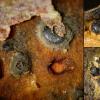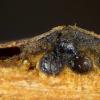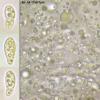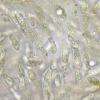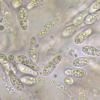
15-12-2025 07:09
 Danny Newman
Danny Newman
indet. Rutstroemiaceae sp. on unk. fallen leavesMc

15-12-2025 21:11
 Hardware Tony
Hardware Tony
Small clavate hairs, negative croziers and IKI bb

15-12-2025 15:54
 Johan Boonefaes
Johan Boonefaes
Unknown anamorph found on the ground in coastal sa

15-12-2025 15:48
 Danny Newman
Danny Newman
Melanospora cf. lagenaria on old, rotting, fallen

15-12-2025 07:05
 Danny Newman
Danny Newman
Pseudosclerococcum golindoi (det: Zotto)near Cosb

15-12-2025 11:49
 Danny Newman
Danny Newman
ITS sequences from the following two collections B

15-12-2025 12:34
 Danny Newman
Danny Newman
indet. Rhytismataceae on oak leafnear Purchase Roa

09-12-2025 12:06
 Andgelo Mombert
Andgelo Mombert
Bonjour,Je recherche l'article concernant Hypobryo
 Hello everybody,
Hello everybody,unfortunately I have another strange pyrenomycete growing on dead attached Ulmus twigs, of which I do not know what it can be. I have seen similarities to Anisogramma, Mamiania and Apioporthe, but there is no species which fits with this one here:
The fruitbodies grow between the surface of the wood and the bark, they consist of a stroma with hairy surface which is somewhat flattened, and several perithecia inside. Macroscopically it reminds me on some Splanchnonema or even Pseudomassaria.
Sp 14-17x5-7µm, clearly apiosporous, hyalin, smooth, I have seen a rest of a hyaline sheath surrounding the spores. Asci with distinct apical apparatus (Congo), IKI-; Sp mostly uniseriate, sometimes partly biseriate.
Any idea?
regards,
björn

This reminds me of a species of Melanconis. Melanoconis chrysostroma has similar ascospores but grows on Carpinus spp. Does it produce conidia?
Dave

I haven't seen any conidia, and I do not believe that it is a Melanconis. I have compared the finding with several species of Melanconis, but it has very different features.
regards,
björn
Hi Björn,
Seems to me too that Anisogramma may be reasonable, but no idea for a species... Nice finding
I think that your species is very closed to Apiospora apiospora. But...
It's an american species growing on Ulmus and Wehmeyer gave : 11-14 x 2.5-5.5 µm, and Ellis & Everhart gave for the basionym Diaporthe apiospora : 11-15 x 6-10 µm.
Perhaps is it an european Apioporthe apiospora ?
Alain

I think Apioporthe apiospora comes closest. The description giving by Wehmeyer has similarities with my finding, except the spore size. But I think it is A. apiospora.
Perhaps there is another idea. I recently find another species on these Ulmus twigs: Eutypella stellulata.
Many thanks to all who have written here until now :)
regards,
björn
I agree with you. In Ellis & Ev. the width is like your one. But as I said, perhaps we can find some little differences between the two continents. Molecular study or culture perhaps would bring the answer to the question.
Eutypella stellulata is a common species in the Old Continent, ouf ! (ouf != ah ! = Ach !)
Alain

but E. stellulata is a new species for me, even if it seems to be common :P ouf ^^
Who is willing to have the Apioporthe for molecular studies?

if you want you can send your specimen to me, I will try to obtain molecular data
Christian

I have to thank Walter Jaklitsch, he has the idea of Melanconiella, which has aberrated spores due to the cold weather.
I am now also sure the substrate is not Ulmus, I have compared the twigs and there had been several from Carpinus, which we had collected per random. At least this was not a professional work, but we have gained a new very interesting species :)
regards,
björn
